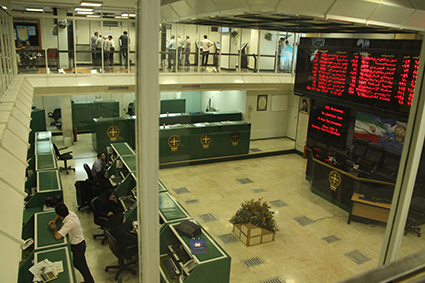Stocks’ midday rallies in Tehran Stock Exchange reversed down due to the ambiguity over the outcome of the nuclear talks between Iran and the P5+1.
In a seesaw trading day, the TSE benchmark finished in red as the TEDPIX resumed its downtrend with a 0.08 percent or 58.5 points to 71,643.8.
Most of the equity market’s indices stepped out of the green territory as the first market index slipped 95.5 points or 0.18 percent to 52,573. The free floating index was down by a 0.08 percent or 65.9 points to 80,738. The industry index ticked lower 31 points or 0.05 percent to end the second trading day at 60,794. The blue chip index was off 9.1 points or 0.28 percent to 3,290.9.
The second market index stood in green being the only positive contributor to the market’s main index with a 0.15 percent or 220.1 points.
The trading value and volume were slightly lower compared to Saturday, as close to 339 million shares changed hands, valued at nearly 941 billion rials.
The TSE announced Saturday that the average Price Earnings (P/E) ratio of the listed companies at the TSE had hit a historic low – something which indicates two different situations occurring in the market.
The first indicator is the high risk of trading at the equity market since the TSE is severely vulnerable to the western sanctions. Besides, the current period of slump in the equity market has been a major contributor to the bearish atmosphere at the TSE.
The second significant factor is the high earnings that can be made from risk-free investment; banks in Iran are a safe haven for investors as they can annually offer a nearly 22 percent interest rate, making them a serious rival for the equity market.
As market analysts believe, veteran traders do not trust the nominal P/E announced by the firms and prefer to calculate analytically as the ratio is in fact the price of shares divided by the earnings of per share and not the company’s budget.
Lack of transparency in the financial reports of the companies has always been a major obstacle for the investors to precisely analyze and predict the companies’ performance, so the skittish mood seems to be persistent in the equity market.
The government along with the Securities and Exchange Organization have planned to tackle the market challenges including the lack of transparency through the implementation of XBRL (eXtensible Business Reporting Language) – a standard for all the listed companies in the TSE.
Besides, due to the stagflation in the capital market, the role of market makers has been highlighted as they can help boost trade, whilst according to some analysts, certain incentives should be offered to encourage the market makers.
As market makers face some limitations in the number of trades, they are highly likely to go bankrupt in a short period of time. But the trend of TEDPIX will change into positive if the limitations are lifted and market makers can easily get the licenses they need for different types of trades, including block trades – when a bulk of a company’s shares are offered on the trading floor.
All respective parties in the equity market are trying to find practical solutions to change the ongoing negative trend of the TSE. To address the equity market challenges, a wide range of contributing factors should be taken into account, and the lack of liquidity should come first in this process.


